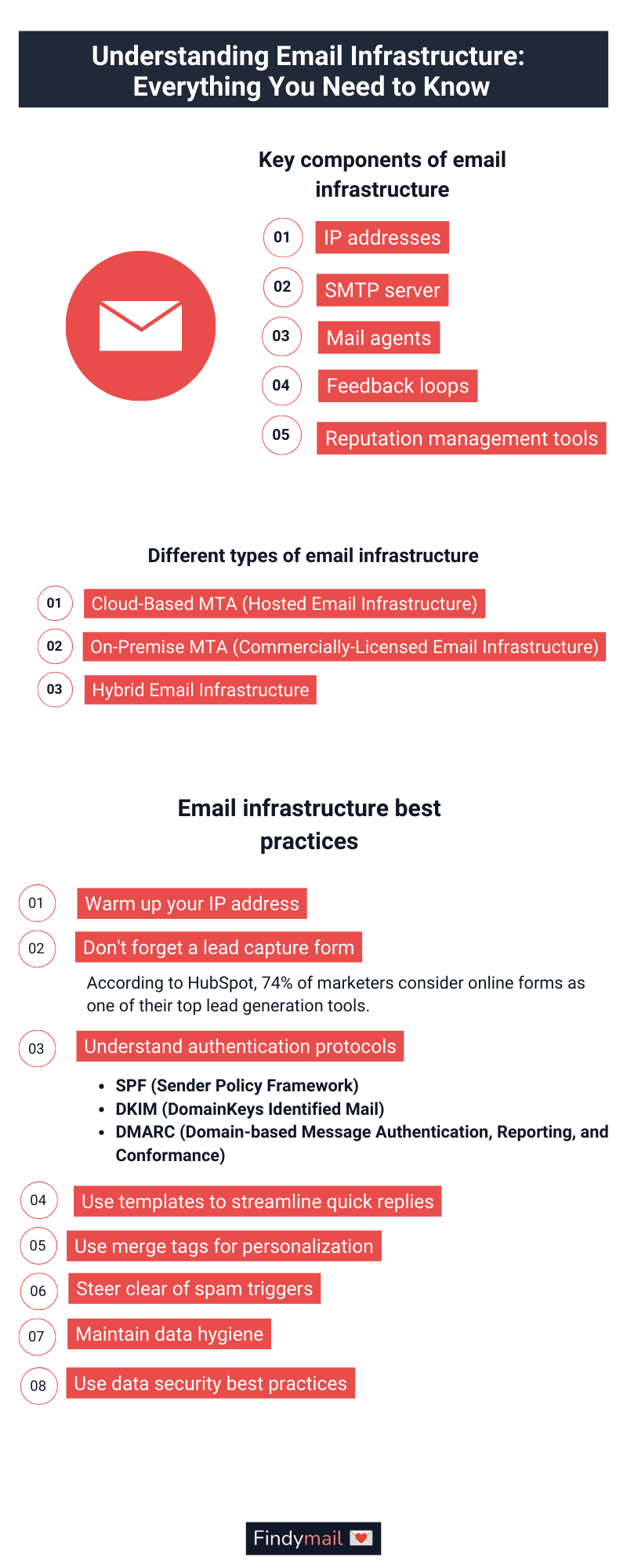As sales reps and marketers, we often focus on crafting killer email subject lines, perfecting our prospecting strategies, and mastering the art of drip campaigns.
But have you ever stopped to think about what's happening behind the scenes?
I'll admit, I used to leave all the technical stuff to the IT gurus and developers. However, understanding email infrastructure can actually have a big impact on the success of your email campaigns.
In this article, I'm here to demystify email infrastructure and show you why it's essential knowledge for anyone in the world of email marketing.
Email Infrastructure Explained
Normally when I hear the word “infrastructure," I think of stuff like roadways, buildings, and bridges. A collection of components that facilitate the movement of goods and people.
Well, email infrastructure is kind of the same, except it’s all about sending and receiving emails.
Think of email infrastructure as the hidden framework that supports everything related to email messages. It's like the backbone of your email operations, consisting of both software and hardware components.
Many companies build their own email infrastructure to streamline communications. And it helps improve customer experience since you can send and reply to customer emails quickly.
Key Components of Email Infrastructure
There are several key components that work together to ensure smooth and efficient email delivery. These are:
IP Addresses
(Source)
In the email world, IP addresses help determine where an email message comes from. Think of them as virtual return addresses. Now, there are two types you should know about: dedicated IP and shared IP.
With a dedicated IP address, it's like having the address to your own house. You have exclusive control over it, and that can be super important, especially for B2B sales.
Maintaining a good reputation for your IP address can help ensure that your emails reach their intended recipients.
On the other hand, a shared IP address means that multiple senders use the same IP. The reputation of that IP is influenced by all the senders, so it's a shared responsibility.
And if you’re associated with an IP that does some shady things, you’re guilty by association.
SMTP Server
(Source)
The SMTP (Simple Mail Transfer Protocol) server acts as a digital post office, making sure your messages get sent and received properly.
Whenever you hit that “send” button, the SMTP server steps in and takes charge. It handles all the behind-the-scenes work, routing your emails to their destinations and ensuring they end up in the right inboxes.
Without the SMTP server, your emails would be lost in the vastness of the internet. So, it's definitely a key player in the email infrastructure.
Mail Agents
Mail agents help make the email magic happen. There are a few different types to know about:
- Mail User Agent (MUA): This is the software or application you use to compose, send, and receive your emails. It's like your trusty sidekick, always there to help you manage your messages.
- Mail Transfer Agent (MTA): The MTA is like the courier that takes care of transferring emails between servers. It ensures that your emails are properly routed and delivered, making sure they reach their intended recipients.
- Message Delivery Agent (MDA): Once the MTA has done its job, the MDA steps in to receive the incoming messages and store them in the recipient's mailbox. It's like the final destination for your email, ensuring it reaches its intended recipient's inbox.
These mail agents work together behind the scenes for smooth email communication, making sure your messages go from point A to point B without any hiccups.
Feedback Loops
A feedback loop is a mechanism that allows email senders to receive notifications and feedback about how recipients interact with their emails.
Now, why does this matter, especially for B2B sales? Well, they let you gain insights into how your recipients engage with your emails. You can find out if they opened your email, clicked on any links, or took any desired actions.
With this feedback, you can analyze what works and what doesn't in your email campaigns. You can make data-driven improvements, craft more engaging content, and personalize your messages to resonate better with your audience.
Reputation Management Tools
Finally, there are reputation management tools. As you guessed, these tools use business analytics and intelligence to measure and monitor your email sender's reputation.
They keep a close eye on factors like email deliverability, spam complaints, and bounce rates. They can also help keep tabs on important email metrics like open rates, click-through rates, and conversion rates.
Reputation management is a must when dealing with emails because it can mean the difference between ending up on a blacklist or getting your cold email game to pop off.
The Different Types of Email Infrastructure
When it comes to email infrastructure, there are different options available to meet your business needs. Let's explore the three main types:
Cloud-Based MTA (Hosted Email Infrastructure)
A cloud-based MTA, or mail transfer agent, is hosted in the cloud by a third-party vendor. It makes it easier to get started without having to invest in physical hardware, and you can handle multiple users.
Here are the benefits:
- Easy scalability: With a cloud-based MTA, you can effortlessly scale your email infrastructure as your business grows.
- Cost-effective: Avoid the upfront costs associated with purchasing and maintaining physical hardware. Instead, pay for the services and resources you actually use.
- High availability: Cloud providers typically have robust infrastructure and backup systems in place, so there’s minimal downtime for your email operations.
- Simplified management: With a hosted email infrastructure, the service provider takes care of hardware maintenance, software updates, and security measures. You can just focus on other important aspects of your business without worrying about the technicalities.
Some examples of cloud-based email systems include Mailchimp, SendGrid, Amazon SES, and Mailgun.
On-Premise MTA (Commercially-Licensed Email Infrastructure)
On-premise email infrastructure is installed and managed within your own physical premises. This gives you full control over your email system.
Here's what you need to know:
- Control and customization: You have complete control over your email infrastructure and functionality.
- Data security: You’ll be able to implement robust security measures and protocols to protect your sensitive data.
- Independence: Operate independently without relying on external service providers. You have complete autonomy over the system's management and maintenance.
- Seamless integration: With an on-premise setup, you have greater flexibility in integrating your email infrastructure with other on-site applications and systems for streamlined workflow and communication.
Hybrid Email Infrastructure
A hybrid email infrastructure combines the best of both cloud-based and on-premise solutions. It offers a flexible and adaptable approach to meet your specific requirements.
Here's what makes it unique:
- Flexibility and scalability: Choose which components of your email infrastructure to host in the cloud and which to keep on-premise. This flexibility allows you to scale specific aspects of your email system based on your evolving needs.
- Data control and compliance: With a hybrid solution, you can maintain sensitive data on-premise while leveraging the scalability and reliability of the cloud for other aspects of your email infrastructure.
- Cost optimization: Leverage the cost-effectiveness of the cloud for certain email services while keeping the more resource-intensive or sensitive aspects on-premise.
Email Infrastructure Best Practices

Whether you're looking at a cloud-based solution or opt to develop an on-premise MTA, follow these tips to ensure the effectiveness and deliverability of your email campaigns:
Warm Up Your IP Address
If you're starting with a fresh IP address, it's crucial to give it a warm welcome. Similar to warming up a new email address, gradually introducing your IP address to the email ecosystem is key.
Start by sending a small volume of emails regularly and gradually increase the volume over time. This helps establish a positive reputation for your IP address, preventing it from being flagged as suspicious by email filters.
By warming up your IP, you improve your chances of achieving better deliverability and inbox placement.
Don't Forget a Lead Capture Form
When it comes to lead generation, a lead capture form is an invaluable tool. According to HubSpot, 74% of marketers consider online forms as one of their top lead generation tools. Including a lead capture form on your website or landing page allows you to collect valuable contact information from potential customers.
Understand Authentication Protocols
Authentication plays a vital role in email security and deliverability. You especially need to know these three key protocols: SPF, DKIM, and DMARC.
- SPF (Sender Policy Framework): SPF helps verify that the sender of an email is authorized to use the sending domain. By configuring SPF records, you prevent spammers from spoofing your domain.
- DKIM (DomainKeys Identified Mail): DKIM adds a digital signature to your emails, allowing recipients' email servers to verify the authenticity and integrity of your messages. Implementing DKIM helps protect against email tampering and ensures your emails are not marked as spam.
- DMARC (Domain-based Message Authentication, Reporting, and Conformance): DMARC builds on SPF and DKIM, providing an additional layer of email authentication. It enables you to specify how email providers should handle emails that fail authentication checks, helping protect your brand reputation and improving deliverability.
Use Templates to Streamline Quick Replies
As your inbox fills up, you'll likely find yourself sending out repetitive replies. Creating templates and using tools to automate these routine responses not only improves efficiency but also enhances the customer experience.
And this one goes hand in hand with my next tip.
Use Merge Tags for Personalization
Personalization is key to the success of any marketing campaign. Merge tags allow you to dynamically insert personalized information such as the recipient's name or other relevant details.
By adding that personal touch, you create a more engaging and customized experience for your subscribers, increasing the effectiveness of your email campaigns.
Steer Clear of Spam Triggers
Certain words, phrases, or formatting choices can make your messages appear spammy to email filters, potentially landing them in the recipients' spam folders or even blocking them altogether.
Here are some common phrases or actions that activate spam triggers:
- "Buy now!"
- "Free money!"
- "Limited time offer!"
- Excessive use of exclamation marks!!!
- Writing in ALL CAPS
- Overuse of promotional language
- Misleading subject lines
If you avoid doing stuff like this, your email campaigns will be more effective.
Maintain Data Hygiene
Data hygiene is often overlooked. You need to keep your email lists up to date, removing inactive or outdated email addresses. Regularly clean your database to minimize bounces and wreck your deliverability rate.
The more reputation and legit your email servers look, the easier it will be to do larger email campaigns and stay out of the spam box.
Use Data Security Best Practices
Don’t ignore the importance of security to safeguard your sensitive data and your customers from potential threats. Falling victim to phishing attacks or malware infections can have severe consequences.
If you're using a cloud-based email system, be sure to follow their recommended security protocols, such as using 2FA. Typically, the vendor will handle the major features like encryption.
For on-premise email systems, you need security measures like firewalls, antivirus software, and regular updates. And you’ll need to train staff to make sure they’re up-to-date on security do’s and don’ts.
If you follow these best practices, you’ll be able to make the most out of your email infra.
Final Thoughts
So there you have it – email infrastructure in a nutshell! I know we often focus solely on crafting compelling email content and implementing winning strategies.
However, understanding the underlying email infrastructure is just as important for our long-term success.
Having this knowledge empowers you to make informed decisions and take actions that positively impact our email deliverability, customer experience, and, ultimately, our bottom line.
You can ensure your messages reach the right inboxes, track customer interactions, personalize your communications, and maintain a stellar sender reputation.
And if you really want to take your email outreach to the next level, you can’t forget about Findymail.
With Findymail, you gain access to a trove of valid and verified email addresses for your leads. No more wasted time on outdated or incorrect contact information.
So give Findymail a try today and get your first 10 emails completely free!






